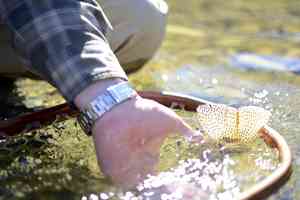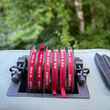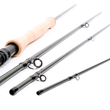The first stretch of Appalachian trout water I laid eyes upon, boulder-strewn and narrow with isolated pockets, was just what I’d imagined it would be. I approached each run camouflaged by the vast green of the forest and, thanks to the diminutive 7-foot 3 weight rod I’d strung up before hiking into the creek, was able to unfurl precise casts despite the ever-present, overhanging limbs. Just around the bend, however, the creek and the forest opened wide. Long runs trailed from the prime pockets, and if I wanted to reach the best water, I’d need a bit more range on my casts. After a few tries, I determined that the little 3 weight wasn’t going to cut it. As luck would have it, I had a 5 weight rodt strapped to my pack that, in addition to being a more powerful implement, at 8’6” offered quite a bit more reach.
But without another reel, without spare spools, and without another fly line, what’s a fellow to do? Wouldn’t you know it?—a perfect opportunity to put to the test the line I had spooled up—Snowbee’s one-of-a-kind XS-Plus Thistledown² fly line.
Snowbee is a British company that’s well known across the Old World and Canada, but a relative newcomer to the States. From rods, reels, line, waders, and even more, Snowbee is a well-rounded fly fishing outfitter and Thistledown just might be their most ambitious and innovative offering.
What makes Snowbee’s Thistledown line so unique is that, unlike any other line on the market, it’s designed to work with widely varying rod weights. The version I had spooled up was the Thistledown 2-5 weight, and Snowbee also makes two other variants—a 1-4 weight and a 5-7 weight.
Can one line perform well on multiple weight rods?
What Works
Versatility
Surprisingly, I never noticed a lick of performance drop when making the jump from the 3 weight to the more substantial 5 weight rod. Line diameter seems to be the key to the puzzling yet delightful adaptability of Snowbee’s Thistledown XS-Plus fly line. Compared to other floating fly lines, the Thistledown line is noticeably thinner and more dense. As a result, there’s less surface area to catch wind on casting strokes.
The grain weight of the Thistledown XS-Plus 2-5 line conforms to AFTM (Association of Fishing Tackle Manufacturers) 5-weight standards. So it’s unsurprising that it works so well on a 5-weight rod. But, one would think that, when lined through the guides of a lighter weight rod, the result would be sluggish action due to severe over-lining. However, one would be wrong. Not only does the Thistledown line produce a pleasing, natural action on lightweight rods, it does so without sacrificing the touch and feel needed for delicate, technical work.
I’ve been scratching my head about how this is possible for a while. Leaning on nothing more than a base-level understanding of the mechanics, I keep going back to the line’s litheness as the explanation for this paradox. I’m still not certain as to exactly how it does this, but I’ve made peace with that uncertainty. As with everything else in the tangible world, it all comes down to physics and math—and physics and math ain’t my strong suits.
Stealth
Speaking of delicate presentations, there’s much to be said for reducing surface disturbance. Many a fine cast has been wrecked by a less-than-perfect follow through, resulting in a fat line plopping down on the water, sending a spooky fish streaking for cover. It happens even to us bass boys in the upper headwaters of smallmouth territory where the fish are as wild as March hares and the water clear as my Sunday morning conscience.
The Thistledown line, as mentioned above, has far less surface area than traditional floating fly lines, which leads to softer landings and oblivious fish.

Satiny
Like a good whiskey, Snowbee’s Thistledown line is smooth, and that makes it easy to work with. There’s an inherent, silky suppleness that resists tangles and slips smoothly through finger and guide. Snowbee says that its Nano-Tec coating is why. Nano-Tec is Snowbee’s trademarked name for its latest line coating tech, which is comprised of ultra thin particles compared to previous technologies. The result, which Snowbee is eager to crow about, is a surface that’s remarkably smoother than those produced by previous processes because the Nano-Tec coating’s microscopic particles leave less negative space, which results in fewer pores. Fewer pores mean fewer grab points for things like rod guides, fingers, water, and air molecules to hang on to. And that means less friction.
Thistledown doesn’t appear to have a memory either, and that’s due its a fine, braided core. I’ve had it spooled on a Snowbee Spectre reel for months and there’s not a wave one on the line.
Strength and Power
Don’t be fooled by Thistledown’s delicate appearance. That braided core heart means that this line can slug it out with the best of them. Back home in Arkansas, I used it to successfully steer a few robust and determined spotted bass from a mass of root wads and through tangles of branches before coming to hand.
Not only can it absorb a blow, but Thistledown can also punch with surprising authority. This is a moderate weight-forward line with a shamrock olive-colored head of 34.5 feet. It’s allowed me to shoot whopper hoppers more than 70 feet with surprisingly little effort on a 5 weight rod.
Buoyancy
One of my bigger worries about Thistledown was that its reduced surface area would also reduce its lift in the water. Again, Nano-Tec coating plays a role here as Thistledown floated high on the currents just like, well… thistledown.
Price
Thistledown retails for $70-$80, which these days is pretty typical for a quality fly line. But considering that one Thistledown line can cover up to four rods, it kind of seems like a bargain.
What Doesn’t
Nothing to gripe about. I might even be spooling a reel with that 5-7 offering in the very near future.
Final Word
Optimistic but deeply skeptical is the best way to describe my initial reaction to the idea of a fly line rated for multiple weight rods. That’s not how this works. That’s not how any of this works, right? You’re supposed to carefully match line to rod. Sometimes even that doesn’t guarantee optimum performance, and you’re left to experiment with different tapers within a line’s weight class. And so, to claim that a line can cover four ranges across the spectrum seems, at best, audacious and, at worst, ludicrous.
But, lo and behold, the skinny and buoyant Thistledown line did just that. And it did it all with aplomb.






























Comments